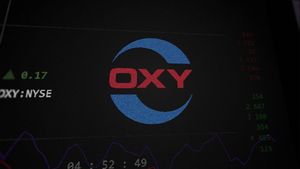
Frankfurt, Germany – October 2, 2025 – European equity markets are currently experiencing an unprecedented rally, with major indices closing at record highs, propelled by a robust global surge in technology stocks and escalating expectations of interest rate cuts by the U.S. Federal Reserve. This bullish sentiment signals a significant shift in investor confidence, highlighting the perceived resilience and growth potential of European equities, even as global commodity markets present a more complex and fragmented picture.
The pan-European STOXX 600 index achieved an all-time high of 568.7 points on October 2, 2025, with Germany's benchmark DAX climbing to 24461 points and France's CAC 40 reaching 8048 points. This widespread market strength underscores a notable re-evaluation of European assets, driven by the dual catalysts of a booming tech sector and a dovish pivot from the U.S. central bank. While the rally is a testament to the market's current optimism, it also raises questions about sustainability and potential ripple effects across various sectors and global commodity prices.
The Dual Engines: Tech Euphoria and Monetary Easing
The current surge in European stocks is primarily a tale of two powerful drivers: a relentless global technology rally and the anticipated easing of monetary policy by the U.S. Federal Reserve. The technology sector, particularly companies involved in artificial intelligence (AI) and semiconductors, has been at the forefront of this advance. European chip-related giants like ASML Holding N.V. (AMS: ASML) and ASM International N.V. (AMS: ASM) have posted substantial gains, reflecting an insatiable demand for advanced processing capabilities worldwide. This momentum was further bolstered by news of OpenAI's significant share sale, valuing the company at $500 billion, and reports of major memory chip suppliers like Samsung Electronics and SK Hynix planning to supply memory chips for OpenAI’s data centers, indirectly benefiting European players in the supply chain. The European tech ecosystem's valuation has surged fivefold over the past decade, reaching $3.2 trillion by October 2025, supported by a significant increase in capital investment and talent.
Concurrently, optimism surrounding anticipated interest rate cuts by the U.S. Federal Reserve has significantly boosted market sentiment. The Fed initiated an easing cycle with a 25-basis-point rate cut in September 2025, marking the first such reduction since December 2024. Market participants now widely expect further cuts, with a high probability (90%) of another reduction in October 2025, partly influenced by a weak private payrolls report. This "dovish pivot" from the Fed is generally viewed as bullish for equity markets, as lower borrowing costs enhance corporate profitability, especially for growth-oriented, technology, consumer, and small-cap companies. The prospect of softer U.S. monetary policy has also diminished the yield advantage of the U.S. dollar, contributing to the Euro's appreciation against the dollar.
The immediate market reaction has been overwhelmingly positive, signaling strong investor confidence in European equities. Beyond technology, other sectors have also benefited; healthcare stocks have seen gains following a U.S.-Pfizer deal related to prescription drug prices, and the automotive sector experienced a boost due to improved new car sales data. Banks and industrials are also among the top-performing sectors this year, benefiting from the prospects of softer monetary policy. Defense stocks, too, have performed exceptionally well, driven by mounting expectations of increased military spending across Europe amidst geopolitical tensions.
Corporate Winners and Losers in a Shifting Landscape
The current market dynamics are creating a distinct divide between companies poised to thrive and those facing headwinds. European technology and semiconductor firms are the clear frontrunners, directly benefiting from the AI-driven rally and lower borrowing costs. ASML Holding N.V. (AMS: ASML), as a critical supplier to the semiconductor industry, and ASM International N.V. (AMS: ASM), a manufacturer of processing equipment, continue to see their shares surge. Other chipmakers like STMicroelectronics (SIX: STM) and Infineon Technologies AG (ETR: IFX), alongside software giants such as SAP SE (ETR: SAP), are also well-positioned. Companies involved in digital automation and energy management, like Schneider Electric (EPA: SU), are also experiencing share price appreciation.
Growth-oriented companies with substantial debt burdens also stand to gain from anticipated rate cuts, as lower borrowing costs enhance profitability and facilitate expansion. Healthcare firms like Novo Nordisk A/S (CPH: NOVO B), with new potential blockbuster drugs, could benefit from reduced financing costs for R&D and market expansion. Automotive giants such as Ferrari N.V. (NYSE: RACE) and Stellantis N.V. (NYSE: STLA) might see increased demand due to lower borrowing costs, and a potentially weakening U.S. dollar could make their exports more competitive. Importers of USD-priced goods and raw materials, such as Germany's major chemical producer BASF SE (ETR: BAS), will also benefit from a stronger Euro, leading to reduced input costs and potentially improved profit margins.
However, a strengthening Euro presents challenges for European exporters, making their products more expensive and less competitive in non-Eurozone markets, particularly the U.S. Luxury goods conglomerates like LVMH Moët Hennessy Louis Vuitton (EPA: MC), Kering S.A. (EPA: KER), and Hermès International (EPA: RMS) could see their sales in the U.S. market impacted if a strong Euro is sustained. Similarly, automotive exporters like Volkswagen AG (ETR: VOW3) might face reduced competitiveness. The European financial sector, particularly banks, faces a mixed outlook. While some reports suggest banks can be top performers, lower interest rates traditionally squeeze net interest margins (NIMs), impacting profitability, though this could be partially offset by a rebound in loan demand. Traditional industries and less innovative companies also face the risk of disruption from rapid technological and AI advancements, potentially losing market share to more agile, tech-driven competitors.
Broader Significance and Historical Context
This European stock rally is not an isolated event but rather a significant development within broader industry trends, with potential ripple effects across global markets and regulatory landscapes. The dominance of technology and AI is a primary underlying theme, with European firms playing an increasingly vital role in the global tech ecosystem. The rally also highlights increased defense spending across Europe due to geopolitical tensions, boosting defense stocks. The industrial sector is also showing strength, poised to capitalize on continued economic growth. Monetary policy easing is anticipated to create opportunities in interest-rate-sensitive sectors like telecoms, real estate, and consumer-facing industries, while Europe's leadership in ecological transition is becoming a significant asset, with expected rate cuts likely to reignite investments in clean energy.
The rally's ripple effects extend globally. The strong performance of European and Asian markets, especially in technology, suggests a potential shift in global economic leadership and resilience, demonstrating an ability to decouple from American political uncertainties. This could lead to increased competition for U.S. tech companies and a re-evaluation of investor portfolios, diversifying capital flows away from a historically U.S.-centric tech investment landscape. The strengthening Euro, while benefiting importers, could negatively impact European exporters, favoring domestic stocks.
Regulatory frameworks, particularly the EU Digital Markets Act (DMA), play a crucial role. Enforced since March 2024, the DMA aims to curb the market power of 'big tech' "gatekeepers" to ensure fair and open digital markets. While aiming to foster competition, concerns exist regarding its potential to stifle innovation and deter investment due to its broad and rigid approach. Monetary policy easing by both the Fed and the European Central Bank (ECB) acts as a crucial tailwind. The ECB is anticipated to cut rates multiple times in 2025, which is seen as more supportive than the outlook for U.S. rate cuts. Furthermore, proposals for increased government spending, particularly by Germany on infrastructure and defense, are significantly boosting European stocks, representing a considerable shift for fiscally conservative nations.
Historically, European equities have shown a remarkable turnaround, outperforming U.S. stocks by the widest margin since 2000 in early 2025, after more than a decade of underperformance. A key factor driving this renewed interest is the relatively lower valuation of European stocks compared to their U.S. counterparts, making them an attractive option for investors concerned about stretched U.S. valuations. This rally can be compared to Germany's economic turnaround in the early 2000s, suggesting that periods of perceived weakness can precede strong market performance. Moreover, low investor expectations going into 2025 created an environment where even slightly better-than-expected performance could trigger a significant rally.
The Road Ahead: Opportunities and Challenges
Looking ahead, the trajectory of European stocks and global commodity markets will be shaped by the interplay of continued technological advancement, central bank policies, and geopolitical stability. In the short term, European stock markets are expected to remain buoyant, with Goldman Sachs Research forecasting the STOXX Europe 600 to rise approximately 5% over the next 12 months, driven by improving economic growth and strong shareholder returns. However, short-term volatility remains a possibility due to factors such as trade tensions and the ongoing U.S. government shutdown, which could delay crucial economic data.
For global commodity markets, the immediate impact presents a mixed picture. Gold and silver have surged to record highs, benefiting from expectations of lower real interest rates, geopolitical uncertainty, and central bank buying. In contrast, crude oil prices have remained steady or even fallen due to oversupply concerns and rising inventories. Base metals show mixed trends, with overall commodity markets expected to remain volatile through 2025 and 2026.
In the long term, European equities are viewed with resilience, balancing current turbulence with structural strengths. Analysts remain positive on European technology stocks due to the sustained growth potential of AI. Europe's shift towards digital transformation and sustainability is expected to create dynamic investment opportunities. However, challenges include weak corporate earnings estimates for 2025 and 2026, geopolitical risks, and potential U.S. tariffs. For commodities, the long-term outlook heavily depends on whether the Fed's easing cycle is "benign" (moderating growth with disinflation) or a response to a recession. In a benign cycle, commodities historically perform very well, particularly energy and precious metals.
Strategic pivots and adaptations will be crucial for both investors and businesses. Investors should prioritize selectivity and diversification, focusing on resilient sectors like technology (AI-related), energy, healthcare, and industrials. Precious metals like gold and silver continue to serve as inflation hedges. Businesses must embrace digital transformation, including AI adoption, and enhance supply chain resilience. Adapting to increasingly stringent regulations, such as the EU Carbon Border Adjustment Mechanism (CBAM), will also be vital for industries like steel and aluminum, requiring updated compliance strategies and carbon footprint tracking.
Market opportunities include the relative undervaluation of European equities compared to U.S. stocks, improving economic growth, and lower borrowing costs. In commodities, gold and silver offer opportunities as safe-haven assets. Challenges include higher current valuations for European equities, the negative impact of a stronger Euro on multinational companies, weaker corporate earnings, and geopolitical risks. For commodities, persistent volatility and oversupply concerns for crude oil remain significant challenges.
Wrapping Up: Navigating the Evolving Market
The current rally in European stocks, fueled by a powerful tech boom and the anticipation of Fed rate cuts, marks a significant moment in financial markets. It underscores a growing confidence in Europe's economic resilience and its burgeoning role in the global technology landscape. While the immediate outlook is largely positive, investors must remain vigilant regarding rising valuations, the potential for a stronger Euro to impact exporters, and persistent geopolitical risks.
Key takeaways include the strong performance of European tech and semiconductor companies, the supportive role of anticipated monetary easing, and the re-evaluation of European equities as attractive investments. Moving forward, the market will be influenced by the pace and magnitude of further Fed rate cuts, the European Central Bank's monetary policy stance, and the evolution of global trade relations.
What investors should watch for in the coming months includes any shifts in central bank rhetoric, particularly from the Fed and ECB, further developments in AI and semiconductor innovation, and the impact of the strengthening Euro on corporate earnings. Monitoring geopolitical events and their potential to disrupt supply chains or impact commodity prices will also be crucial. While the "Bronzeilocks" scenario—where the Fed cuts rates due to moderating growth without triggering a recession—is the base case for continued commodity performance and equity growth, investors should also prepare for potential recessionary or sticky inflation scenarios. Adaptability, selective investment, and a keen eye on macroeconomic and geopolitical developments will be paramount for navigating this evolving market landscape.
This content is intended for informational purposes only and is not financial advice.





